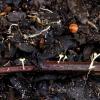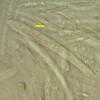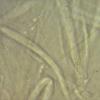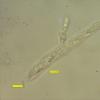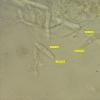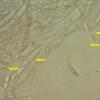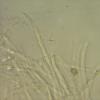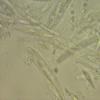
09-11-2025 13:20
Hello.A tiny ascomycete, appearing as erupting gra

08-11-2025 00:29
 Francois Guay
Francois Guay
I found this species in Quebec, Canada, on herbace

04-11-2025 09:07
Hello.A suspected Hymenoscyphus sprouting on a thi

04-11-2025 12:43
 Edvin Johannesen
Edvin Johannesen
Hi! One more found on old Populus tremula log in O

03-11-2025 21:34
 Edvin Johannesen
Edvin Johannesen
These tiny (0.4-0.5 mm diam.), whitish, short-stip
Hymenoscyphus scutula?
William Slosse,
09-07-2017 10:27
 I found following species in damp litterlayer in Alnuswood growing on dead remains of Rumex sp stems.
I found following species in damp litterlayer in Alnuswood growing on dead remains of Rumex sp stems.- spores: hyalien, fusiform (?), filled with many tiny drops, 20.61x4.17um
- asci: uni to biseriated, 85-83 x 8.5 um, no crosiers
- paraphyses: slender, slightly thickened to the tip
Can anyone confirm if i'm wright?
Thx in advance,
William
Lothar Krieglsteiner,
09-07-2017 10:38

Re : Hymenoscyphus scutula?
Hello William,
yes, surely a member of the H. scutula-complex.
Typically, H. scutula ss.str. has cilia at the ends of its spores, they are sometimes difficult to see. But there are similar forms without, called H. vitellinus. I am not sure if there is actual research about this, so I don`t know if vitellinus is a good species.
Best regards from Lothar
Hans-Otto Baral,
09-07-2017 10:49

Re : Hymenoscyphus scutula?
Hallo zusammen
I am not very sure from the photos that the spores are scutuloid. They are mutliguttulate which is not very typical of H. scutula. So I cannot exclude H. menthae (= H. consobrinus).
The H. scutula aggregate is still unclarified, an there are only few sequences so far.
Zotto
I am not very sure from the photos that the spores are scutuloid. They are mutliguttulate which is not very typical of H. scutula. So I cannot exclude H. menthae (= H. consobrinus).
The H. scutula aggregate is still unclarified, an there are only few sequences so far.
Zotto
William Slosse,
09-07-2017 10:56

Re : Hymenoscyphus scutula?
Thx for your quick feedback, Lothar.
I couldn't find any cilia therefor I doubted.
Best regards,
William
I couldn't find any cilia therefor I doubted.
Best regards,
William
William Slosse,
09-07-2017 10:58

Re : Hymenoscyphus scutula?
Thx for your interesting remarks.
I will look further on that species and compare it with the records of menthae.
Best regards,
William
I will look further on that species and compare it with the records of menthae.
Best regards,
William
Bernard Declercq,
11-07-2017 11:06

Re : Hymenoscyphus scutula?
Hi William,
I agree with Zotto. The guttulation of the spores excludes H. scutula ss. str. as well as its form without cilia. Spores are typical H. menthae, as well as the white stipe of the apothecia. That single scutuloid spore does not belong to this species.
Moreover, in Belgium, we collect H. scutula not earler than in the second half of August.
Bernard
I agree with Zotto. The guttulation of the spores excludes H. scutula ss. str. as well as its form without cilia. Spores are typical H. menthae, as well as the white stipe of the apothecia. That single scutuloid spore does not belong to this species.
Moreover, in Belgium, we collect H. scutula not earler than in the second half of August.
Bernard
Hans-Otto Baral,
23-11-2020 20:35

Re : Hymenoscyphus scutula?
Hi William
I just made a mistake in replying your request about an orange discomycete on Research gate.
Please send me a link to your fungus.
Zotto

